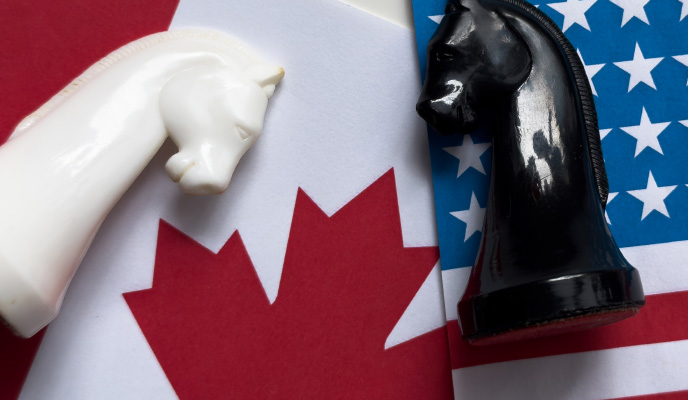Authors’ note. This article was prepared on April 22, updated on July 15, and is accurate as of that date. Please refer to legal counsel for up-to-date information on the status of the trade and tariff measures between Canada and the United States.
Since his inauguration in January, US President Donald Trump has undertaken a series of aggressive actions aimed at challenging the foundations of the global trade system. Chief among them are sweeping tariff measures that have provoked widespread retaliatory responses, strained diplomatic and economic relations, and dramatically altered global trade dynamics. The ripple effects of these changes have significantly disrupted international supply chains.
These tariff measures are especially notable in the context of recent US trade history, because they are being implemented solely by the executive branch, without involvement from Congress. As a result, there has been significant volatility in the scope of imports affected and the level of duties imposed, since President Trump has unilaterally and rapidly proposed—and at times reversed—a number of these actions by executive order.
Due to its geographic proximity and deep economic integration with the United States, Canada has been particularly affected. Most Canadian exports are destined for US markets, and nearly half of all foreign direct investment in Canada comes from US investors.1
As a result, Canadian businesses now find themselves navigating a volatile and uncertain trade environment with their most critical economic partner. Tariffs imposed on Canadian exports, US goods, and other components within shared supply chains pose significant challenges to operational and financial stability. However, businesses are not without options. Businesses can take several strategic steps to mitigate the impact of these trade measures.
This article outlines ten practical actions Canadian businesses can take to adapt to, and potentially benefit from, the evolving realities of this trade dispute.
1. Conduct a Comprehensive Supply Chain Assessment
The first and most essential step for businesses is to review their supply chains to evaluate their exposure to cross-border trade. This assessment includes identifying direct exports to the United States, imports from the United States into Canada, and any other cross-border movements involving jurisdictions affected by tariffs.
If a company maintains operations in the United States or other countries, the review should address the impact of tariffs on cross-border trade in those jurisdictions, too. Additionally, businesses must consider their indirect exposure, such as goods sourced from suppliers that may themselves be affected by tariffs.
Beyond tariffs, the assessment should also factor in potential exposure to nontariff barriers, including export restrictions, quotas, or bans on critical products, as well as possible discriminatory practices in government procurement at the federal, provincial, or state levels.
2. Identify Goods Subject to Specific Measures
Building on the supply chain review, companies must identify whether the goods they import or export are subject to specific trade measures. For example, the United States has levied targeted tariffs on sectors such as steel and aluminum. In retaliation, Canada has implemented its own tariffs, including on US steel and aluminum, that seek to match the impact of US tariffs on a dollar-for-dollar basis, which affect a broad and diverse range of products beyond just steel and aluminum across multiple industries.
To properly evaluate their exposure, businesses should closely examine the categories of goods that underpin their supply chains and determine whether any of those items cross the US–Canada border and are affected by the trade measures. It is also necessary to monitor those trade measures since, as noted above, the list of goods subject to tariffs, and the tariffs and surtaxes to which they are subject, changes constantly.
3. Identify Exemptions That May Reduce Tariff Impacts
The US and Canadian measures include exemptions and carve-outs for certain classes of goods. For example, as of the date of this writing, US tariffs on Canadian goods enacted under Executive Order 14231 exclude goods that qualify for—and claim—preferential treatment under the United States-Mexico-Canada Agreement (known in the United States as USMCA and in Canada as CUSMA).
More specific and nuanced exemptions may apply as well. For example, aluminum products “smelted and cast in the United States” are excluded from tariffs imposed under Proclamation 10782. Determining eligibility for such exemptions often requires gathering detailed documentation and conducting a legal analysis—typically with support from legal counsel.
Additionally, some tariffs may apply at reduced rates. For example, under Executive Order 14193, while a general duty rate of twenty-five percent applies to most imports, a ten percent duty rate applies to “energy and energy resources” imported from Canada. Executive Order 14156 defines “energy” and “energy resources” to include “crude oil, natural gas, lease condensates, natural gas liquids, refined petroleum products, uranium, coal, biofuels, geothermal heat, the kinetic movement of flowing water, and critical minerals.” Businesses in the energy sector should carefully review whether goods in their supply chain fall within this preferential category.
4. Review Customs Declarations and Key Drivers of Tariff Liability
Importers should conduct a detailed review of their customs declarations to identify factors that drive the assessment of liability. These drivers include:
- tariff classification: accurate classification determines whether a product falls within the scope of specific tariff measures;
- value for duty: the determination of the declared value of goods, which forms the basis for calculating certain tariff amounts, is subject to complex rules and can be a nuanced process; and
- country of origin: tariff applicability often hinges on the true origin of a product, which importantly may differ from the country of export. Determining origin requires a clear understanding of production processes and international rules of origin.
Careful analysis and, where appropriate, strategic adjustments to these declarations can significantly reduce exposure to tariffs. Given the highly detailed, complicated rules around these declarations, it is advisable to work with customs professionals and/or legal counsel to ensure compliance while identifying potential savings.
5. Make Use of Preferential Treatment Under CUSMA
As noted above, US tariff measures often exclude goods that qualify for preferential treatment under CUSMA. Canadian exporters should assess whether their goods meet the necessary rules of origin and ensure they have proper documentation in place.
However, businesses must also be vigilant against false claims—particularly in light of the potential for transshipment or diversion of goods by third parties seeking to exploit CUSMA benefits. This caveat is especially relevant given the sweeping US tariffs imposed on its global trading partners.
Determining whether a product qualifies for preferential treatment under CUSMA can be complex, especially for processed and manufactured goods. Key considerations include:
- Substantial transformation. This criterion asks, Has the good been so significantly transformed during the production process that the final good is classified differently from its constituent goods?;
- Indirect materials. This criterion requires consideration of goods used in production, testing, or inspection, but not incorporated into the final product; and
- Production location and regional value content. These criteria contemplate certain required percentages of the value of the goods being sourced and/or produced from and in a specific signatory country. This assessment requires review of the place the goods are produced, not necessarily their place of export.
False origin declarations can result in significant liabilities. Border authorities on both sides of the border actively audit these claims. Accordingly, it is important that companies understand the certification process and document the rationale for why their goods qualify before making a claim for preferential treatment under CUSMA.
6. Consider Whether Tariff Relief May Be Available
In exceptional circumstances, the Canadian government will consider specific requests for tariff relief through remission. Such relief is generally reserved for situations where:
domestic alternatives for certain inputs are unavailable or insufficient;
- no reasonable substitute exists from non-US sources; and
- a strong public policy rationale exists, such as the supply of essential goods or mitigation of an otherwise severe adverse impact to the Canadian economy.
- To apply, businesses will generally need to submit detailed information regarding the company claiming relief, the relevant goods that are subject to surtaxes, whether there are Canadian alternatives to sourcing the goods, and how those goods are used by the requesting company.
Although relief is not guaranteed and likely limited, businesses that play a vital role in Canada’s economic or supply chain infrastructure should evaluate whether they may qualify.
The Canadian government has also introduced several remission orders to provide immediate relief from Canadian tariff and surtax measures for certain importers. One example is the United States Surtax Remission Order (2025), issued on April 16, 2025. This order applies to many goods imported before October 16, 2025, providing a six-month reprieve from certain retaliatory tariffs or surtaxes imposed by Canada in response to trade actions taken by the Trump administration. The remission order is broad, covering goods imported for Canadian manufacturing, processing, and food and beverage packaging and those used to support public health, health care, public safety, and national security objectives. Businesses should evaluate whether the remission order and similar measures apply to them while they remain in effect.
7. Review Contracts, and Seek Proactive Negotiation With Trading Partners
Tariffs can create ambiguity and tension in cross-border commercial relationships. Businesses should revisit their contractual arrangements, with the assistance of trade law counsel as needed, to determine who bears the financial burden of new trade measures. Key points to assess include:
- Allocation of tariff-related costs. Are these expenses explicitly addressed in the contract?
- Incoterms (international commerce terms). Do your shipping terms inadvertently assign tariff liability to your business?
- Force majeure and change-of-law clauses. Do they apply in the context of sudden tariff impositions?
- Defined terms. Is the term “tax” defined such that it would include or exclude tariffs or retaliatory surtaxes? Are the terms “tariff” and “import taxes” defined?
Where gaps or risks are identified, companies should engage in proactive negotiations with suppliers, distributors, and partners to clarify responsibilities and share the burden equitably (or in alignment with the parties’ expectations).
Businesses should review their contractual agreements with cross-border trading partners to determine which contracting party will be responsible for additional costs caused by the tariffs and how these additional costs will be apportioned. This review will become an increasingly important element of cross-border trading partnership due diligence and should be taken into account when negotiating new contracts or updating prior contracts with cross-border trading partners. In particular, businesses should ensure that their incoterms do not inadvertently accrue tariff liability.
Importantly, it can be difficult to determine and isolate costs that arise from tariffs rather than from other sources. This determination is particularly relevant to tariffs that may impact goods upstream in a supply chain and are passed down to the company.
8. Consider Options for Assembly Facilities Abroad
Businesses whose goods are assembled in a jurisdiction that is not their target market may wish to consider building assembly facilities in their target market, particularly if the goods at issue have high value. Assembling goods in the target market based on imported components, rather than shipping finished products into the target market after assembling them elsewhere, may minimize the customs value of goods that are subject to duties.
This option is a major strategic undertaking that requires a thorough analysis of production costs, market access, regulatory risk, and various tax implications. Companies should also consider the potential for trade measures to be rolled back before committing significant capital to new facilities.
9. Diversify Your Trading Base
Over the longer term, Canadian businesses should consider how to diversify their trading base to reduce overreliance on the US market so as to avoid future trade disruptions.
Canada is uniquely positioned, since it is currently the only G7 nation to have free trade agreements in force with all other G7 members. These agreements, including the Comprehensive and Progressive Agreement for Trans-Pacific Partnership (CPTPP) and the Canada-European Union Comprehensive Economic and Trade Agreement (CETA), open doors to new sourcing and export opportunities. Canadian companies can also leverage government resources, such as trade commissioner services, to explore new markets and build international relationships.
10. Work With Tax and Trade Advisors
The legal and commercial implications of tariffs and trade measures are complex and continually evolving. Engaging tax and trade professionals early in the process can help ensure that businesses take full advantage of exemptions, relief measures, and strategic planning opportunities.
Before implementing any of the strategies discussed, consult with advisors who understand the regulatory landscape, supply chain risks, and financial consequences specific to your industry.
Conclusion
The trade measures introduced under President Trump’s administration have dramatically reshaped the global trade environment, particularly for Canadian businesses with deep ties to the US economy. Although the challenges are significant, they are not insurmountable.
By proactively assessing their supply chains, understanding applicable trade measures, and pursuing strategic responses from contractual renegotiation to supply diversification (including diversifying trading bases, considering assembly facilities abroad), Canadian businesses can mitigate the impact of tariffs and build resilience for the future.
Flexibility, vigilance, and expert tax and trade law guidance will be essential in navigating the shifting trade landscape. No solution is universal, but the strategies outlined here provide a robust framework for responding effectively to trade disruptions and positioning for long-term success.
Randy Schwartz is a partner in the national tax group at the law firm McCarthy Tétrault. Martha Harrison is a partner in the firm’s international trade and investment law group and in its retail and consumer markets group. Ljiljana Stani is a partner in the litigation and international trade and investment law groups at McCarthy Tétrault. Gajan Sathananthan is an associate in McCarthy Tétrault’s international trade and investment law group. All four authors are based in the firm’s Toronto office.

Endnotes
- “Canada and the United States: The Numbers on a Unique Relationship,” Statistics Canada (March 21, 2023),
www.statcan.gc.ca/o1/en/plus/3250-canada-and-united-states-numbers-unique-relationship.




